Contents

On-demand webinar
How Good is My Shield? An Introduction to Transfer Impedance and Shielding Effectiveness
by Karen Burnham
A multilayer PCB has more than two layers in its stack-up. Stack-up is one of the most important aspects of your design. It describes how layers are arranged in a multilayer board. An accurately stacked board will reduce electromagnetic emissions and crosstalk and improve signal integrity.
What is a PCB stack-up?
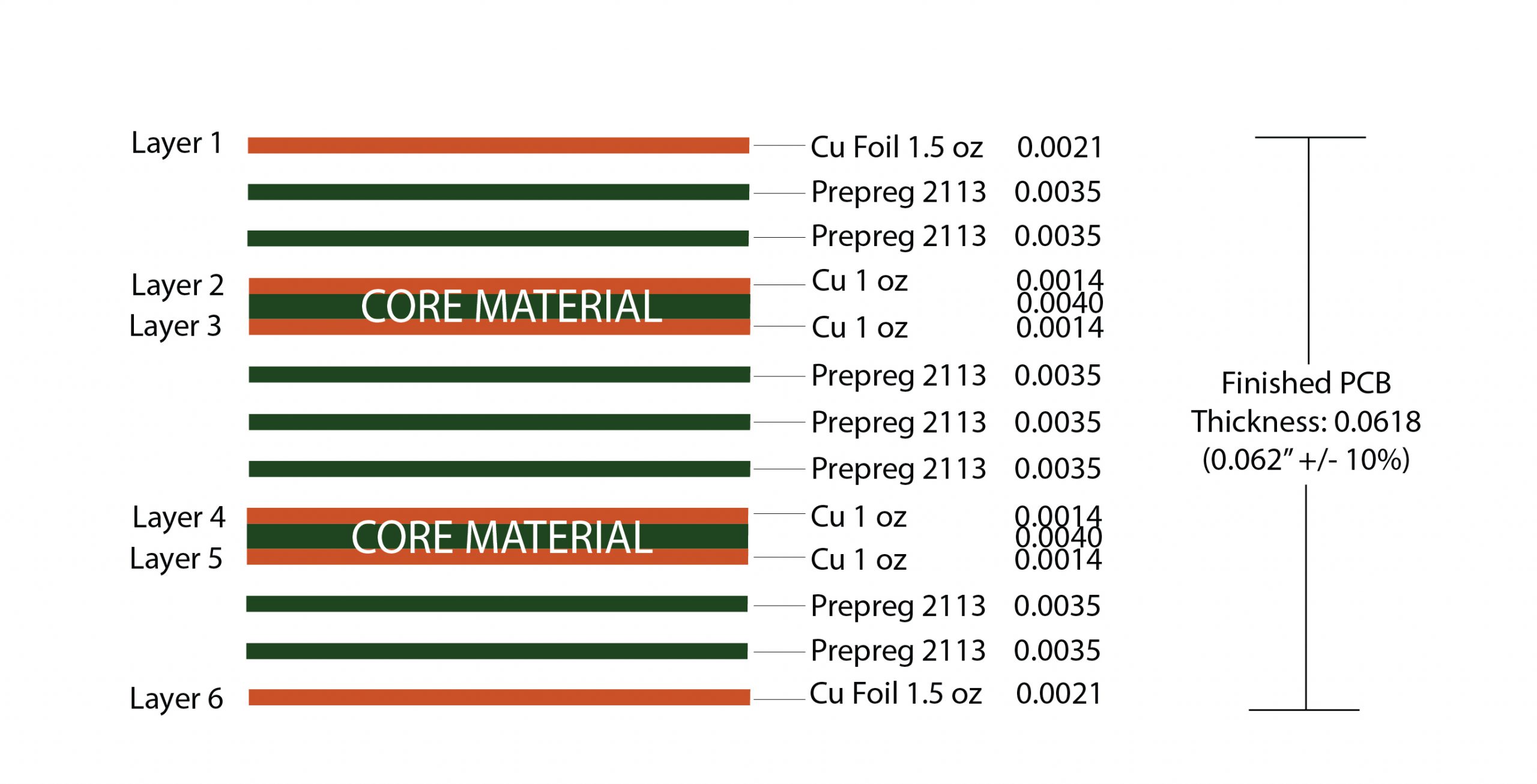
Stack-up describes the construction of a multilayer board in sequential order. It provides vital information like material thickness and copper weights required to fabricate a PCB. Stack-ups are also referred to as build-ups.
A stack-up also gives the details of trace width for different controlled impedance traces, such as 50 ohms or 100 ohms differential. The above image shows an example of a 6-layer stack-up.
What are the different layers present in a circuit board?
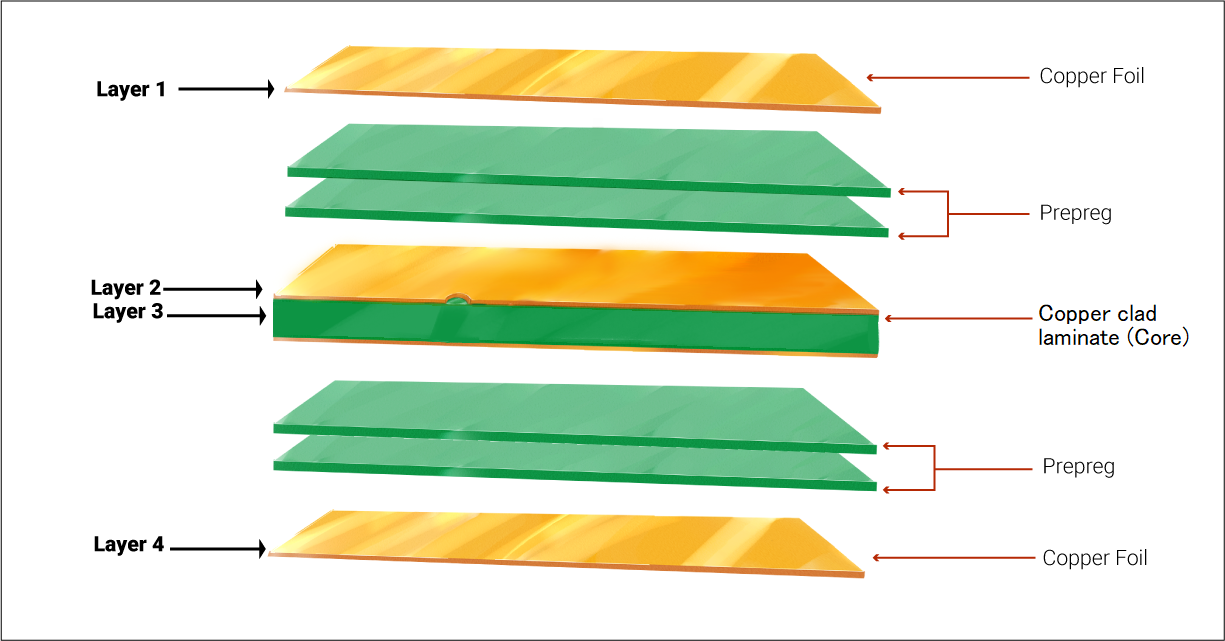
A stack-up primarily consists of metal foil, prepreg, and copper-clad laminate (core).
Metal foil: Copper is the most commonly used metal foil in PCB construction.
Prepreg: It is an interwoven glass cloth impregnated in epoxy resin. The resin is left semi-cured.
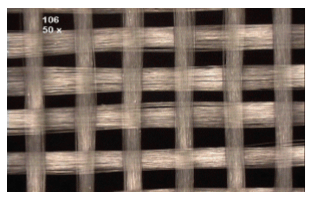
Copper-clad laminate: Single or multiple plies of prepreg bonded together along with the top and bottom copper foil makes a copper-clad laminate. This is also known as the core.
Power and ground layers in PCB stack-up
The power plane is a copper layer connected to the power supply. It is often designated as VCC in PCB design. The main function of the power plane is to provide a steady voltage supply to the PCB.
In multi-layered boards, if a component needs to draw power, then it is simply connected to the via that makes contact with the power plane. Similarly, the ground plane is a plane of flat copper connected to the common ground point in the PCB.
Advantages of using power/ground planes
- The power and ground pins of the components can easily be connected to the power and ground planes.
- It provides a clear current return path, especially for high-speed signals, which reduces EMI (electromagnetic interference).
- The power planes have a larger current-carrying capacity than the traces, which reduces the PCB’s operating temperature.
What is PCB lamination?
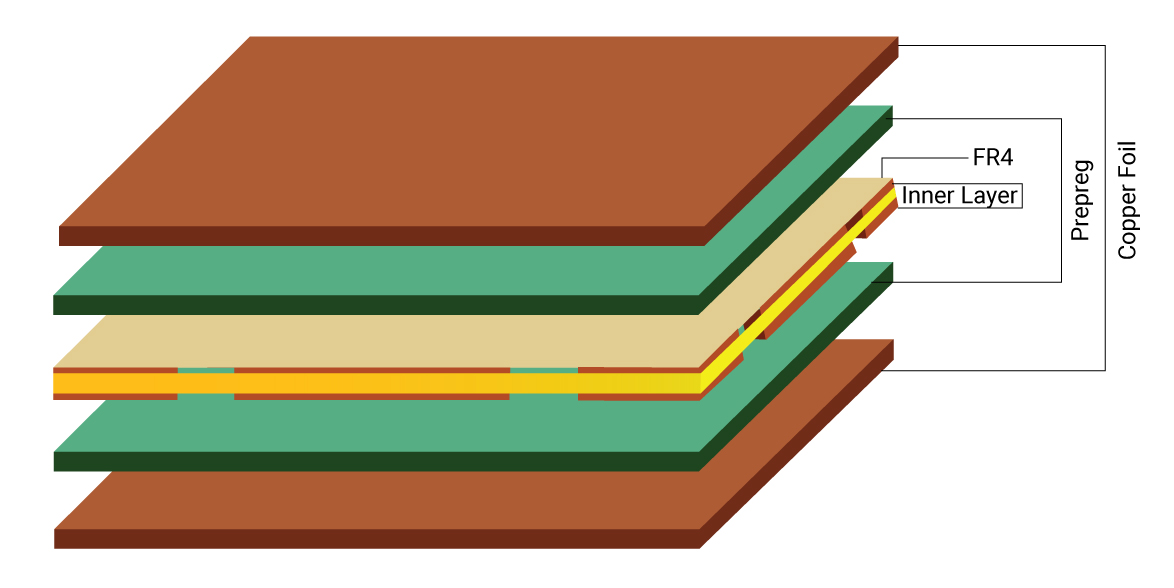
The lamination is the process of placing the stack-up under extreme temperature and pressure to bond prepreg and copper foil to the base PCB inner layers. The temperature and pressure values are mentioned in the datasheets of the chosen PCB materials.
PCB Stack-Up Design Guide
12 Chapters - 55 Pages - 60 Minute ReadWhat's Inside:
- Design guidelines for HDI, flex, and hybrid stack-ups
- Stack-up representation in fab drawing
- DFM checks for layer stacks
- Characteristics of high-speed materials
- Manufacturing tolerances
- PCB stack-up examples with illustrations
Download Now
What is the standard board thickness?
The thickness of a PCB mainly depends on factors such as copper thickness, materials used, number of layers, and the operating environment.
The standard thickness of a conventional board is around 62 mils (1.57mm). Today, PCBs have become more complex as the copper layer weight and the layer count have increased for various applications.
Due to this, the PCBs tend to become thicker. Manufacturers, based on the customer’s request, are now fabricating PCBs with two new standard thicknesses, 93 mils (2.36mm) and 125 mils (3.17mm) (150% and 200% of the old standard thickness).
Why do we need multiple layers in a PCB?
Electronic devices are becoming more complex and consist of a higher number of components and circuits. It becomes tedious to accommodate complex circuits in a single-layered PCB. This problem can be solved by adding layers to the stack-up.
Let us have a look at a few advantages of multilayer boards:
- They are capable of accommodating complex circuits that are required for modern electronic devices.
- Having more layers means the board is thicker and, therefore, more durable than single-sided PCBs.
- Multi-layer boards require more planning and intensive production processes, so they are of a higher quality than other types of boards.
- Using multiple PCB components would require multiple connection points. Multi-layer boards, on the other hand, are designed to work with a single connection point, simplifying the design of the electronic device and further reducing the weight.
How are multilayer circuit boards made?
Step 1: Inner layer core selection
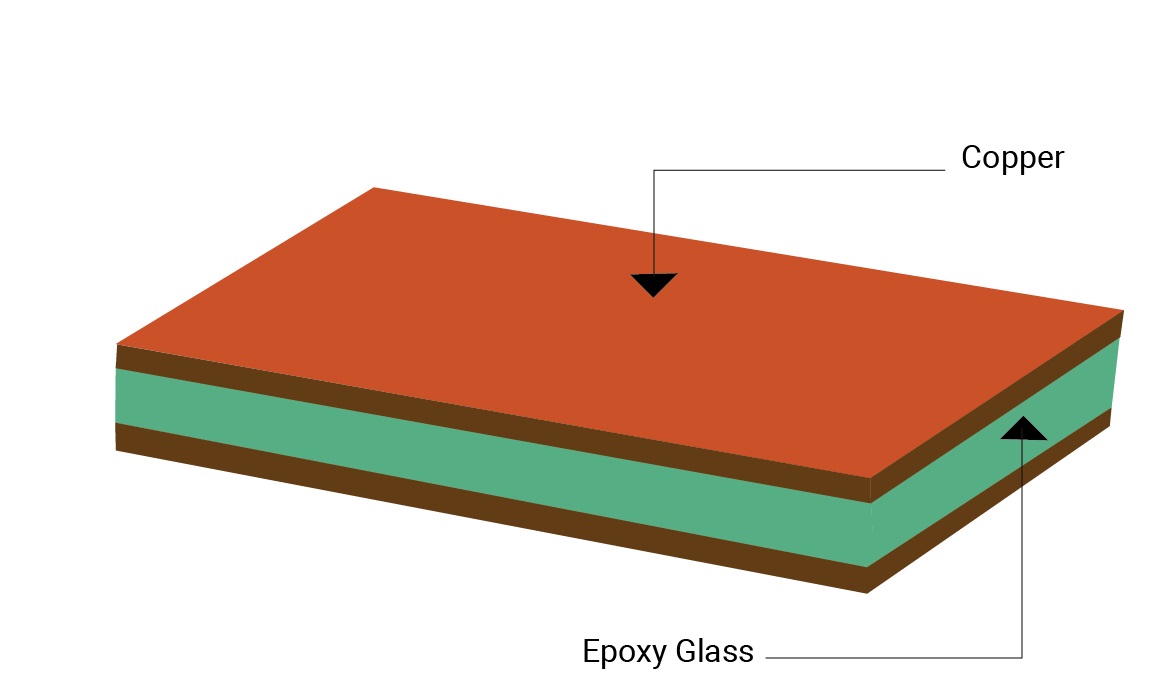
The stack-up designates the materials to be used for the manufacture of a multilayer circuit board. The build-up provides the following information:
- The copper thickness and weight
- Type of epoxy glass to be used
- Panel size
Step 2: Cleaning
The inner layers are cleaned chemically/mechanically or both to remove contaminants from the copper surface.
Step 3: Inner layer imaging
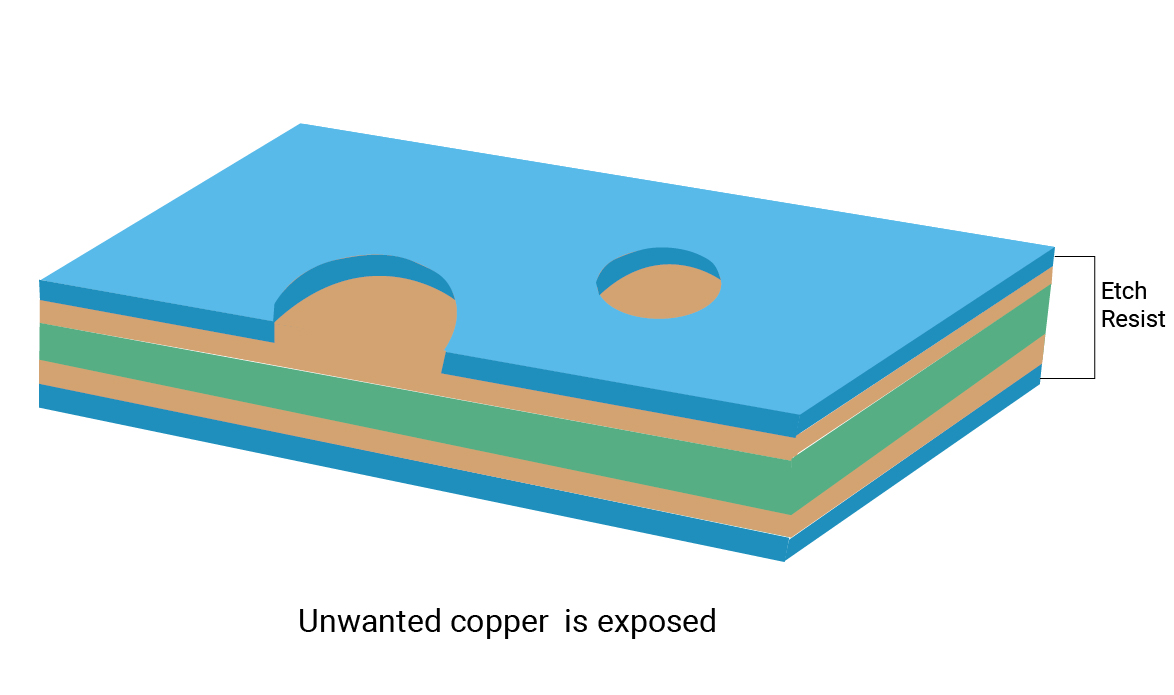
The imaging material is placed on the copper surface. It covers the desired copper circuitry and exposes the unwanted copper.
Step 4: Etch stripping
The inner layers are chemically etched to get rid of the unwanted copper. The photoresist is then stripped off to reveal the copper circuitry.
Step 5: Automated optical inspection
Automated optical inspection is carried out to find the flaws(shorts/opens in inner layers) that can’t be detected by the human eye.
Step 6: Oxide treatment
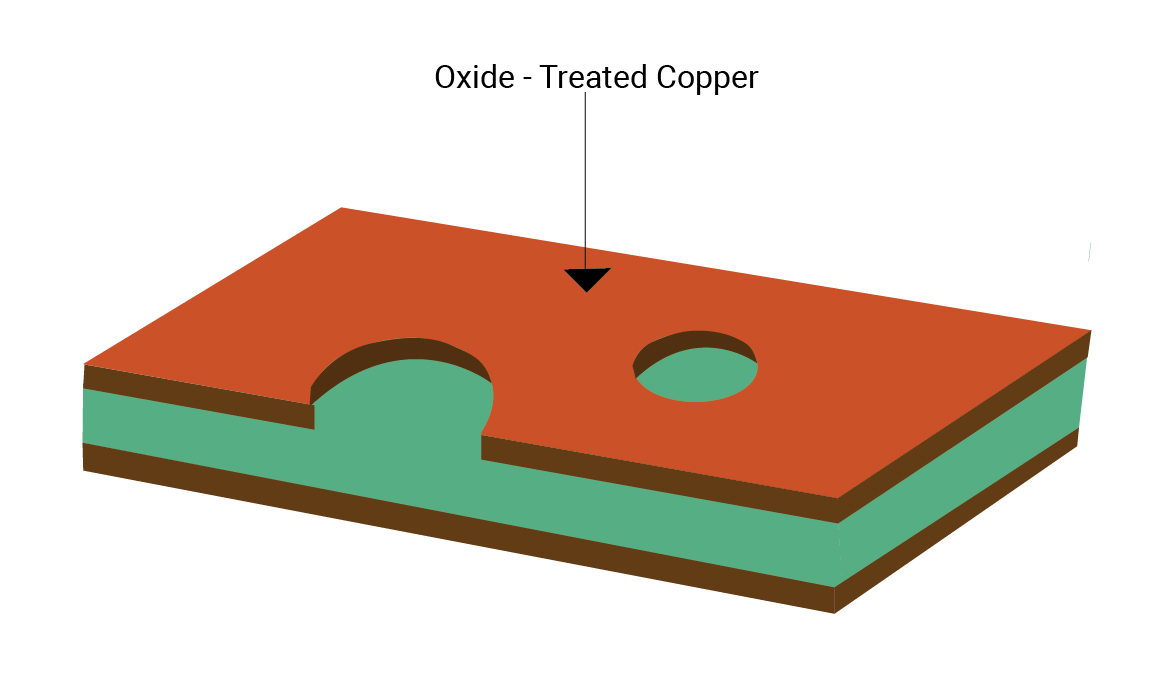
The exposed copper circuitry on the inner layer must be treated before lamination to improve adhesion. Improved adhesion also increases the structural strength and overall board reliability.
Step 7: Layup
Steps 1 to 6 are repeated for all the inner layers. For example, these steps will be carried out for layers 2, 3, and 4, 5.
Step 8: Lamination
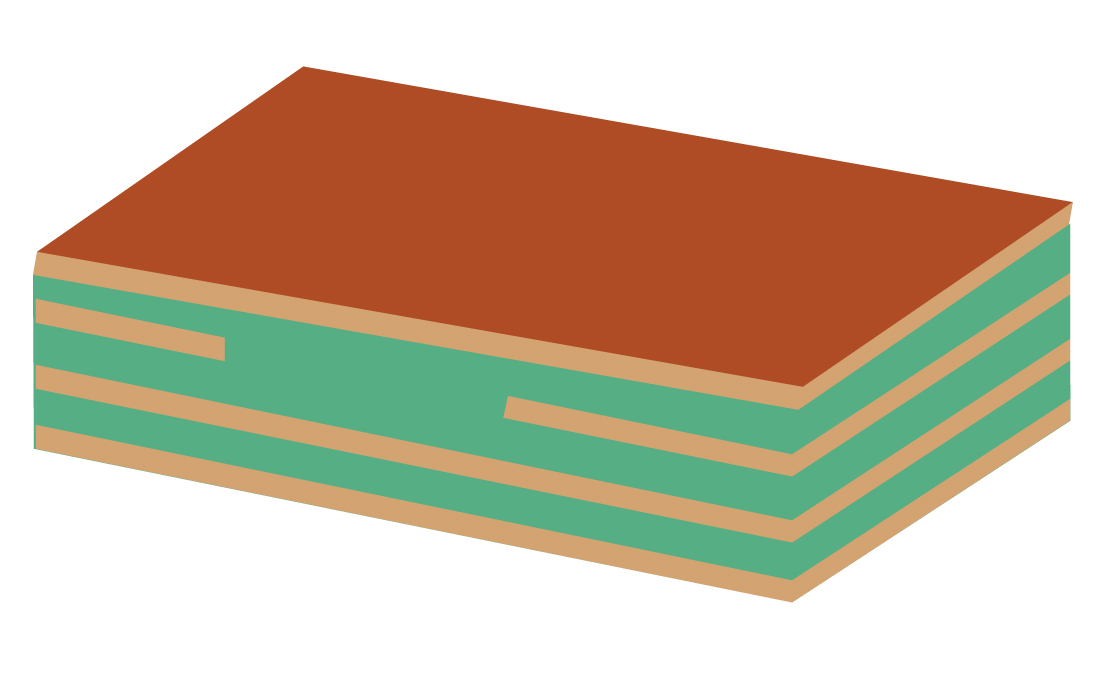
In this step, the stacks are pressed and heated in a vacuum chamber. The lamination process begins by applying a vacuum to remove all the entrapped air and gases. Later, heat and pressure are applied to the stack so the resin in the prepreg undergoes a molecular bonding. Check out our article to learn about the causes of lamination voids.
Step 9: Drilling
After the lamination process, the laminated board is loaded on a panel of exit material on the drill bed. The holes are drilled on the PCB to make vias and through holes.
The exit material lessens the burr formation. Burr is the protruding part of copper formed when the drill spindle penetrates through the board. To learn more about drilling, check out our article PCB Drilling Explained: The Do’s and the Dont’s.
Step 10: Deburring and desmearing
In this step, the copper burrs formed during the drilling process are removed. It also removes any fingerprints on the copper surface. Desmearing is the process of removing friction-melted resin during the drilling process.
The epoxy smear is removed by immersing the PCB panel in a series of chemical solutions followed by potassium permanganate or concentrated sulfuric acid. Desmearing can also be performed by plasma treatment.
Step 11: Copper plating of drill holes
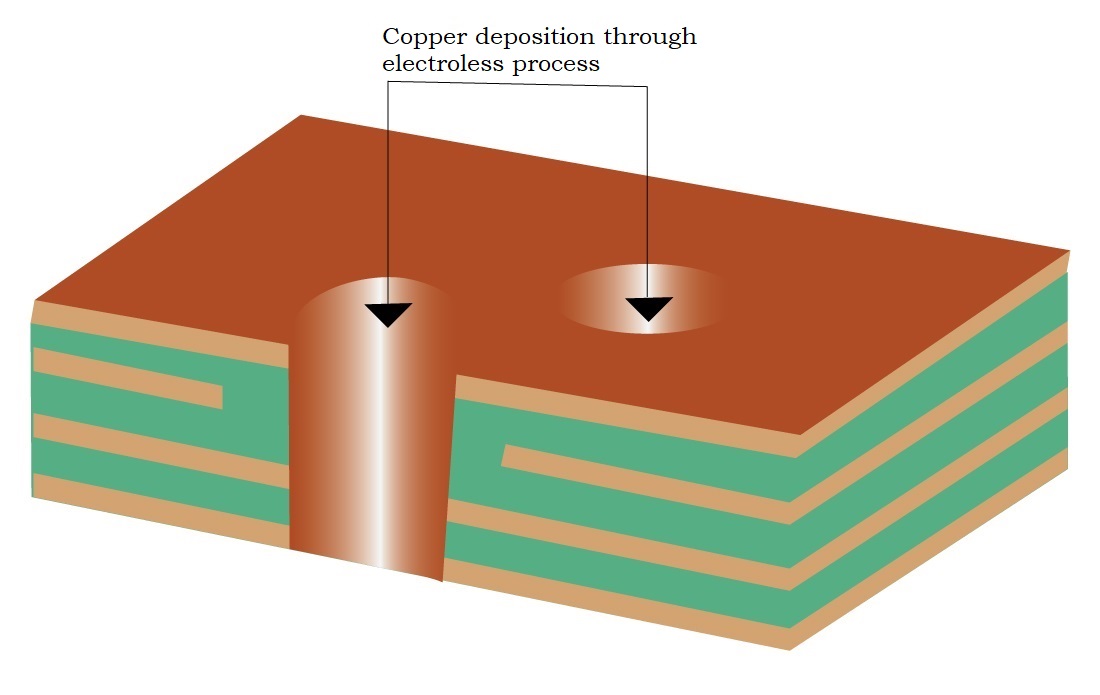
After deburring and desmearing, drill holes are copper-plated using an electroless method.
HDI board stack-ups
High-density interconnect, or HDI, circuit boards are printed circuit boards with a higher wiring density per unit area than traditional printed circuit boards. In general, HDI PCBs include microvias, blind vias, buried vias, built-up laminations, and high signal performance considerations.
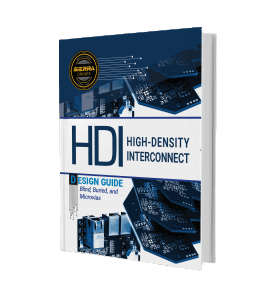
HDI PCB Design Guide
5 Chapters - 52 Pages - 60 Minute ReadWhat's Inside:
- Planning your stack-up and microvia structure
- Choosing the right materials
- Signal integrity and controlled impedance in HDI
- Manufacturing considerations for higher yields
Download Now
Sequential lamination
PCBs are manufactured by layering an epoxy pre-impregnated fiberglass sheet between the copper layers. These layers are laminated together under high temperatures and pressure.
Sequential lamination is a process of inserting a dielectric between a copper layer and a laminated subset (laminated layers).
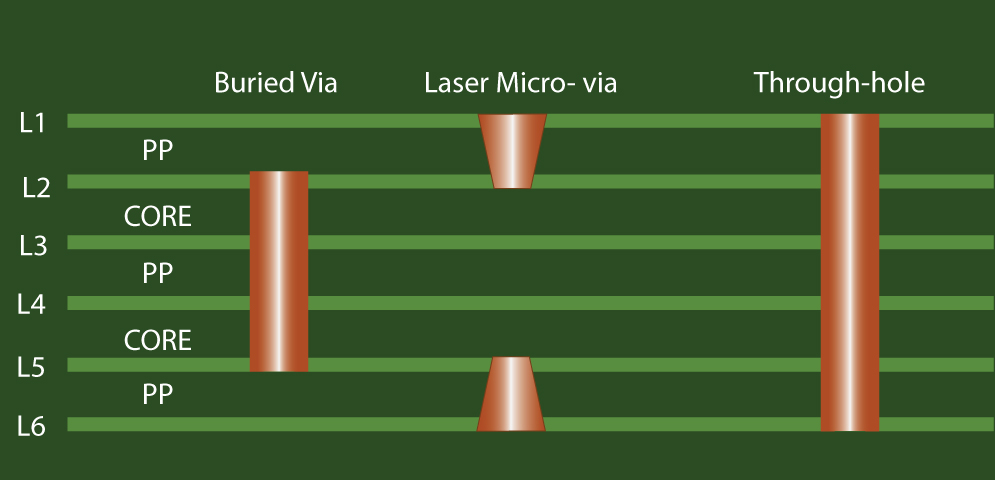
Buried vias can be built into HDI boards using a sequential lamination process. The first step is to fabricate the layers that are connected through a buried via (layers 2, 3, 4, and 5 in the given stack-up). Next, the outer layers (layers 1 and 6) are laminated, and the microvia holes are drilled.
Now, let us assume that this design requires a connection between L1 & L3; L6 & L4. The best way to achieve this design is to use staggered or stacked vias as shown below.
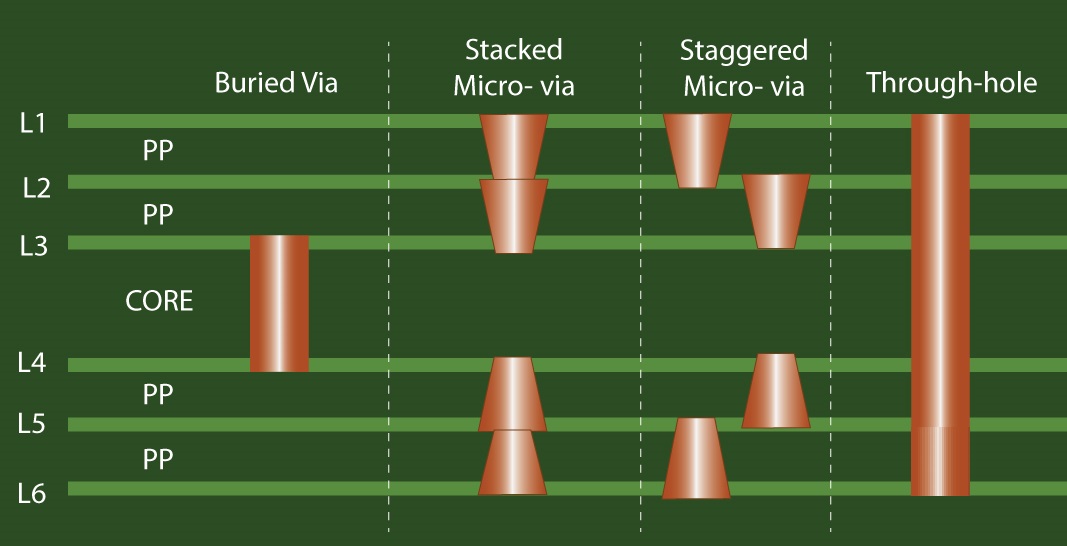
In the stack-up above, we can see that the micro-vias are stacked and staggered. Stacked vias are more space-efficient. However, they are less reliable and require complex manufacturing, which increases the manufacturing price.
Staggered vias essentially mean fewer process steps. We do not have to fill the laser-drilled vias with copper because the second laser drill does not land on the first laser drill. Filling or plating a microvia shut usually happens in a special plating tank designed with chemistry.
It plates the laser-drilled microvia from the bottom of the via to the top of the via until it fills the hole completely. Plating a laser-drilled microvia shut adds time and cost to the process.
Nomenclature of HDI stack-ups
The HDI stack-up architecture is differentiated into stack-up classes depending on the number of microvia layers and the number of inner layers between the microvias. These classes are determined by the formula X-N-X, where x is the number of microvia layers, and N is the number of inner layers between the microvias.
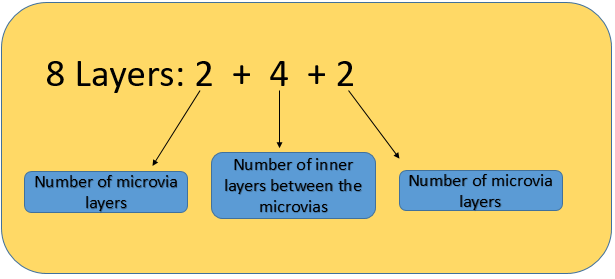
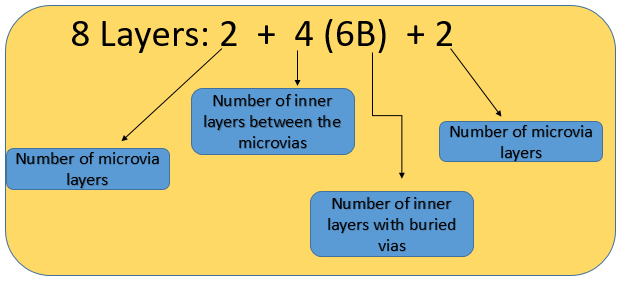
Examples of HDI stack-up
1+4+1 stack-up
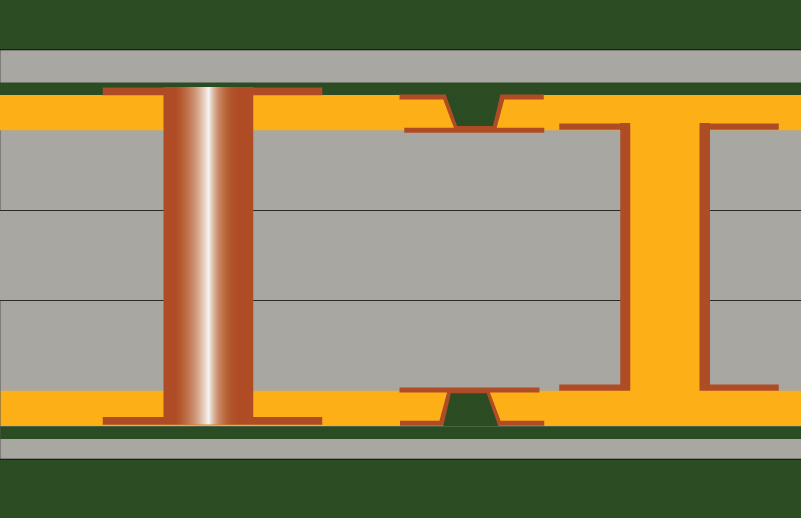
The above stack-up shows an example of a 6 layer stack-up(1+4+1) with one microvia layer on either side of the board.
2+4(6b)+2 stack-up
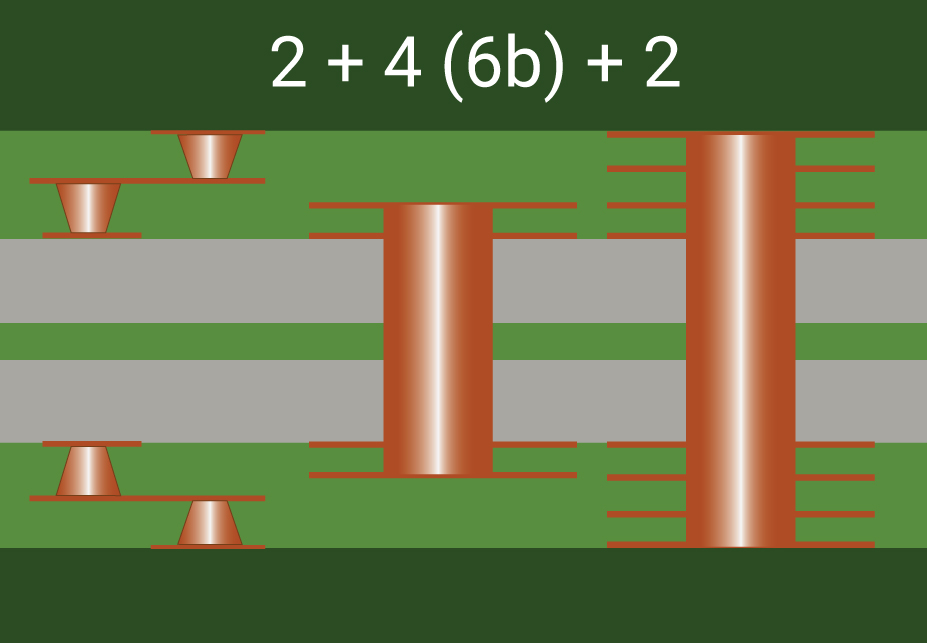
The above image shows an example of 8 8-layer stack-up with two microvia layers on either side of the board and 6 buried via layers between the microvia layers.
PCB stack-up recommendations for designers
The cost of a board needs to be optimized as low as possible. To achieve this, the following points need to be considered:
- Every layer of sequential lamination requires extra time and processes. Therefore, more number sequential laminations increase the cost and delivery schedule. It is best to limit the sequential layers to 3 or fewer.
- Stacked vias require filling after every sequential layer. This requires more manufacturing process steps and time. Therefore, staggered vias are recommended if stacked vias can be avoided.
- Mention clearly when requesting a stack-up from the manufacturer the layers between which the mechanical buried vias are required and the requirement of staggered and buried vias.
- Some materials are not suitable for sequential lamination. The suitability of the materials for sequential laminations should be verified by the manufacturers.
A successful PCB design relies heavily on the stack-up. A well-designed stack-up enables designers to optimize their designs for better signal integrity and reduced crosstalk and EMI.
In this article, we have covered the basic aspects of PCB manufacturing. Let us know in the comment section if there are any specific topics that you would like to read more about.




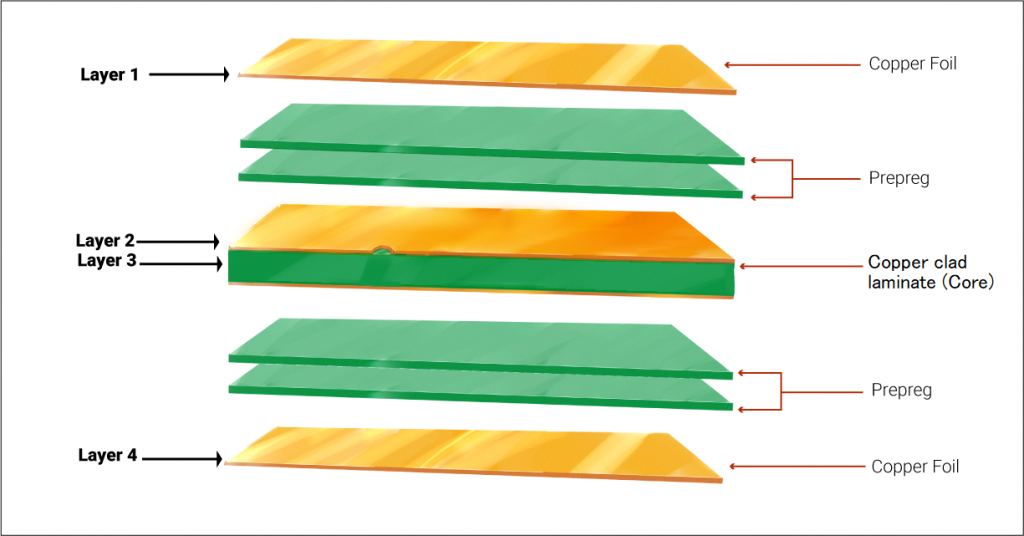




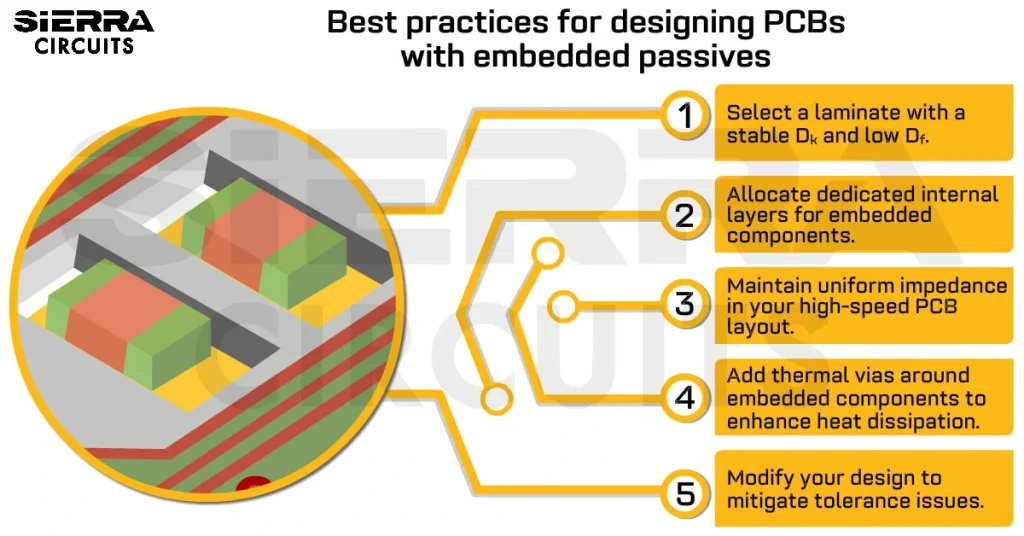
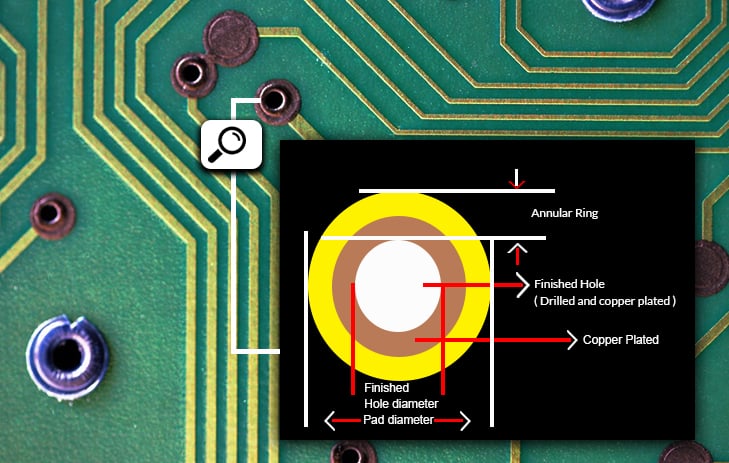
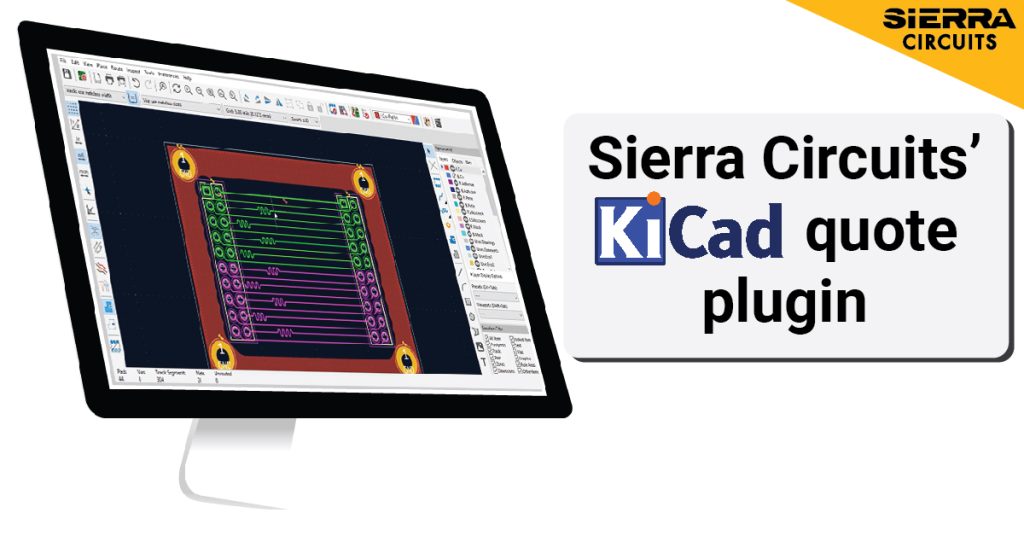
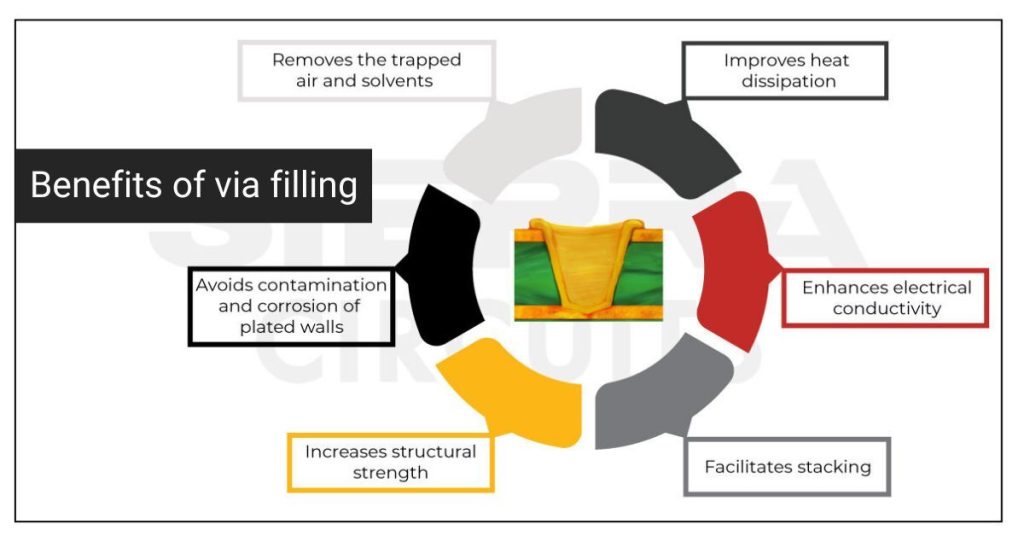




Start the discussion at sierraconnect.protoexpress.com